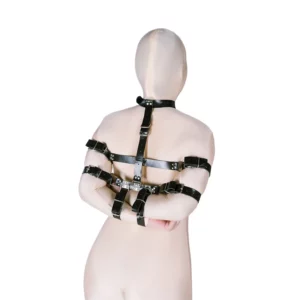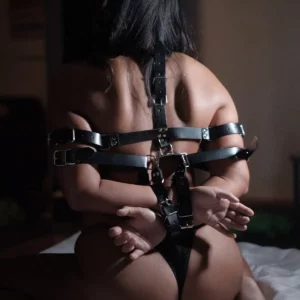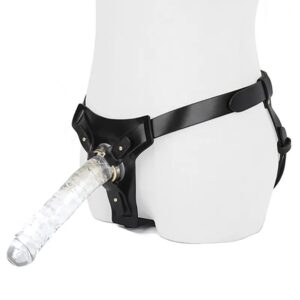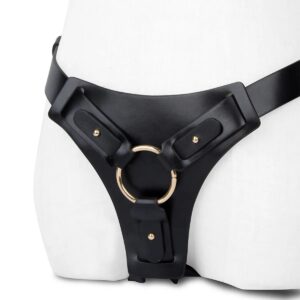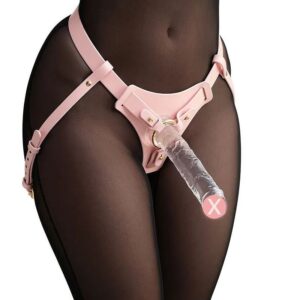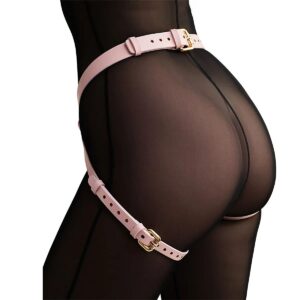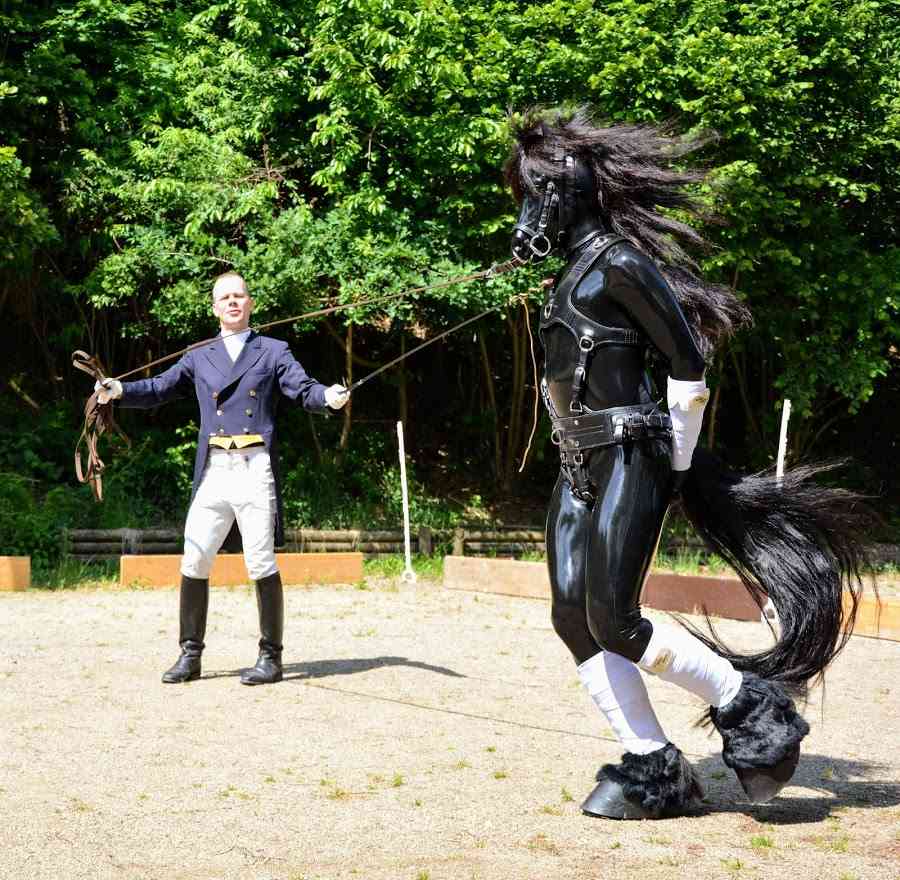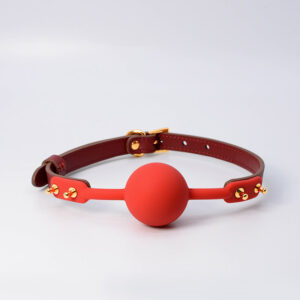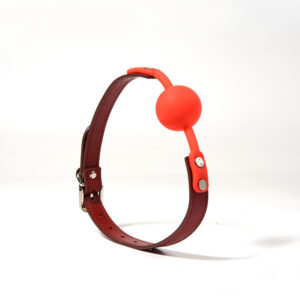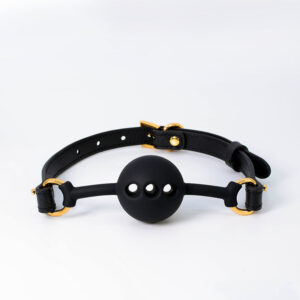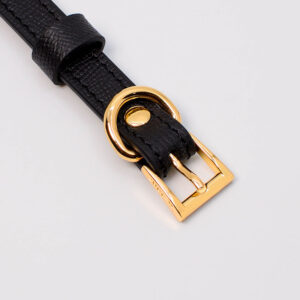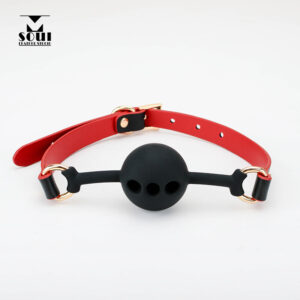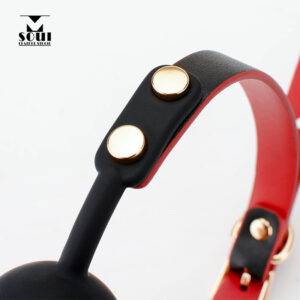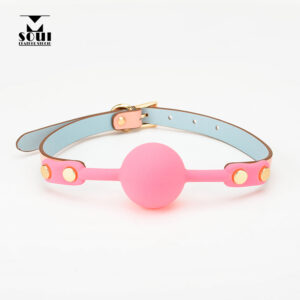Ponyplay often includes techniques from real equestrian sports. There are also different types of human horses: breeding horses, dressage horses, pony boys and girls or work horses. Some have to or are even allowed to pull carriages or sulkies and perform tricks. Many ponies have a trainer, handler or tamer (a person who trains the human horse) gives it commands and more. To outsiders, pony play often seems bizarre. Not just because of the look, but also because of the elaborate staging of the horse and trainer.
Contents
ToggleWhat is Ponyplay?
In the BDSM context, ponyplay (or pony play) is a type of pet play that involves slipping into the role of a horse. It’s about imitating an animal, but it doesn’t describe sexualized contact with animals. Outfits that are reminiscent of costumes as well as typical accessories such as bridles, whips and reins are often used. The person who takes on the horse role tries to embody a real horse as authentically as possible.
Even if you see many examples of equipped human horses on the Internet, such equipment is not absolutely necessary. Pony play is also possible without a battle of materials, because it’s much more about the mindset, the feeling.
In pony play, a distinction is also made between kinksters who actually think like real horses within their role as a horse and want to behave and be treated accordingly. This is referred to as petspace, a specific form of subspace. On the other hand, there are the ponyboys/ ponygirls (people who experience a power imbalance through being dressed up and treated as horses). The latter often do not behave exclusively like horses, but also retain their human sexuality in their role.
Why people like ponyplay?
Ponies have high value in pop culture. They appear in various comics, films, radio plays and series. Interestingly, some pony players say that “playing with horses” in kindergarten was their introduction to BDSM. For many people, pet play and pony play are a way to get rid of who they are for a while. By stepping into the animal, or in this case horse, role, you allow yourself to feel more on a more visceral level. As an animal, it is often all about recognizing, interpreting and obeying commands. Not having to decide every step yourself can be very relaxing.
With a horse, a lot of non-verbal communication is used during dressage and when it is led by an owner. Feeling this and continually improving and deepening it through play with one another can be something very intimate and create a bond. It’s not just about trust and obedience. Horses are strong animals that test their limits and rank. As a human horse, it doesn’t have to be primarily about submission. An exchange and dynamic often arises between pony players that differs from many other pet play variants.
If you engage in ponyplay as a ponyboy or ponygirl, the allure may also be found in the element of humiliation. Performing your role in the presence of an audience, executing tricks, and being led on a rein can evoke a sense of embarrassment. This is akin to donning a bridle or gag that restricts speech. Ponyplay outfits often incorporate bondage elements and are crafted from materials such as leather or latex. Particularly when the dominant figure exerts control by bullying, using a whip, or asserting sexual dominance over the submissive human ponyboy or ponygirl, it creates a thrilling exchange of power for all participants involved.
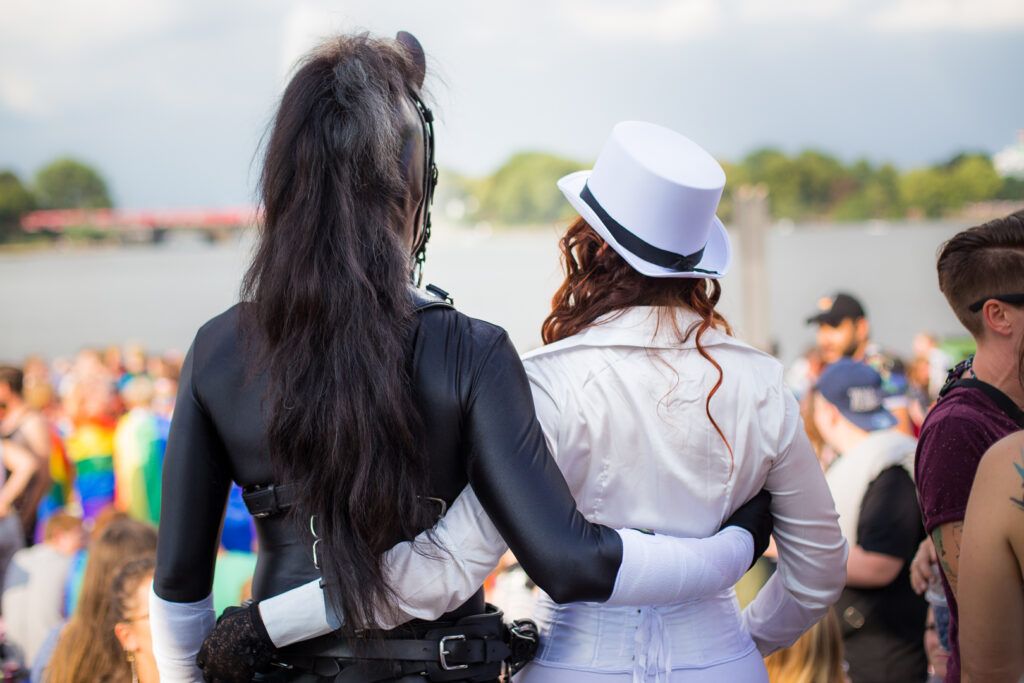
Types of Ponies in Ponyplay
Show Ponies
Show ponies are all about presentation. They revel in the attention, often showcasing their grace and elegance during ponyplay events. Grooming and attire are crucial for show ponies as they aim to steal the spotlight.
Work Ponies
Work ponies find fulfillment in performing tasks for their handlers. Whether pulling carts or carrying out specific duties, these ponies take pride in their ability to be useful and industrious.
Pet Ponies
Pet ponies emphasize the playful and affectionate aspects of ponyplay. They seek companionship and often enjoy being pampered and loved by their handlers, fostering a deep bond beyond the typical roles.
Cart Ponies
Cart ponies excel in pulling carts or carriages, showcasing their strength and endurance. This type of ponyplay often involves training and discipline to ensure seamless cooperation between the pony and handler.
Racing Ponies
For those with a competitive spirit, racing ponies engage in speed contests. Agility and swiftness are prized attributes as these ponies dash to victory in specially designed courses.
Ponyboy and Ponygirl
The distinction between ponyboys and ponygirls lies in gender expression within the ponyplay community. Both types encompass a range of characteristics and activities, emphasizing the diversity and inclusivity of ponyplay.
Costumes and Attire in Ponyplay
The essence of ponyplay lies in the transformation, and costumes are the magical garments that facilitate this change. Tailored to resemble the equine aesthetic, these outfits contribute to the fantasy, allowing participants to step into the role of playful ponies.
Latex and Leather Ensembles: Sleek latex or leather outfits, often designed to mimic the sleek coats of horses, are a popular choice. These materials not only look visually striking but also add a sensual texture to the experience.
Bridles and Headgear: Elaborate bridles, headgear, and masks are essential components. These pieces not only serve a functional purpose in guiding the pony but also enhance the visual appeal, often featuring intricate designs and embellishments.
Tailored Bodysuits: Full-body suits with hoof-shaped feet and hand covers create a seamless transition from human to pony. These suits add a layer of authenticity and commitment to the role.
Decorative Harnesses: Decorative harnesses, adorned with embellishments and accessories, add an extra layer of flair. Whether simple or intricate, these pieces contribute to the overall aesthetic of the pony.
Jewelry and Adornments: Delicate jewelry, such as pony-themed necklaces or bracelets, can complement the outfit. Adornments like ribbons or bows add a touch of playfulness.
Ankle and Wrist Cuffs: Cuffs, often matching the bridle or harness, are used to enhance the submissive experience. They can be functional or purely decorative, depending on the scene.
Tail Plugs and Belts: Tail plugs, combined with matching belts, provide an essential visual element, transforming the lower half of the body into a distinctive equine form.

Training and Commands in Ponyplay
Basic Commands
Walk, Trot, Canter: These fundamental commands mirror the gaits of a horse. “Walk” initiates a leisurely pace, “Trot” quickens the tempo, and “Canter” introduces a spirited gallop, allowing Handlers to orchestrate a dynamic and visually engaging performance.
Halt and Stand: Commands like “Halt” bring the Pony to a complete stop, emphasizing discipline and responsiveness. “Stand” cues the Pony to remain still, adding an element of poise to the performance.
Turn and Circle: Maneuverability is honed through commands dictating left or right turns and circular movements. These actions showcase the Pony’s agility and responsiveness to the Handler’s guidance.
Building Trust Through Positive Reinforcement
Treats and Affirmation: Handlers employ positive reinforcement, using treats, verbal praise, or affirming gestures to reward desired behavior. This not only motivates the Pony but also deepens the connection between both participants.
Consensual Play: Training sessions emphasize consensual play, ensuring that both Handler and Pony are actively engaged and comfortable with the chosen commands. Regular communication and check-ins further solidify trust.
Advanced Maneuvers
As proficiency grows, Handlers may introduce advanced maneuvers, such as side-stepping, pivoting, or even playful jumps. These intricate moves add layers of skill and theatrics to the ponyplay experience.
What to Pay Attention to in Ponyplay
Sensitivity to Non-Verbal Cues: Handlers must develop a keen sense of equestrian intuition, attuned to the non-verbal cues of their Ponies. Subtle shifts in body language, expressions, or energy levels convey valuable insights into the Pony’s state of mind.
Physical Well-being: Handlers should prioritize the physical well-being of their Ponies. Regular health checks, ensuring appropriate rest intervals, and addressing any physical discomfort are essential to sustaining a healthy and consensual ponyplay experience.
Creating a Safe Space: Handlers must pay attention to the environment in which ponyplay unfolds. Ensuring a safe, clean, and adequately equipped space minimizes risks and contributes to the overall well-being of both parties.
-
25.99$
-
25.99$
FAQs
Is Ponyplay Inherently Sexual?
While ponyplay can have erotic elements, it’s not strictly sexual. Many participants find pleasure in the roleplaying, and the aesthetic aspects of ponyplay without a sexual component.
Can Anyone Engage in Ponyplay?
Ponyplay is consensual and can be practiced by adults of any gender. It’s essential to ensure all participants are informed, willing, and comfortable with the dynamics involved.
Are There Different Roles in Ponyplay?
Yes, there are typically two main roles: the Handler and the Pony. The Handler guides and trains the Pony, while the Pony assumes the role of the equine submissive.
Do I Need Specialized Gear for Ponyplay?
While specialized gear can enhance the experience, it’s not mandatory. Basic elements include a bridle, bit, and possibly a tail plug. Participants can gradually explore additional gear based on their preferences.
Can Ponyplay Be Practiced Publicly?
Some individuals enjoy public displays of ponyplay, but it’s crucial to choose appropriate venues and ensure the comfort of all participants. Public scenes should align with the rules and atmosphere of the chosen space.
Are There Different Styles of Ponyplay?
Yes, ponyplay can vary widely. Some prefer a more traditional equestrian style, while others explore fantasy or even gothic themes. The style can be tailored to the preferences and imaginations of the participants.
Final Words
If you’re interested in pony play, there’s no reason not to give it a try. You shouldn’t let the bizarre look or the fear of doing something wrong stop you from experiencing something new. After all, no perfect horse has fallen from heaven! It’s best to first find out whether the horse’s behavior and/or the role as a pony player really suits you before you invest a lot of money in the right equipment. Things can get very expensive here. Especially when it comes to latex masks, elegant halters and custom-made items. All of this is nice to have for lovers, but not a must for pony play. A gag will also do the trick for starters.

